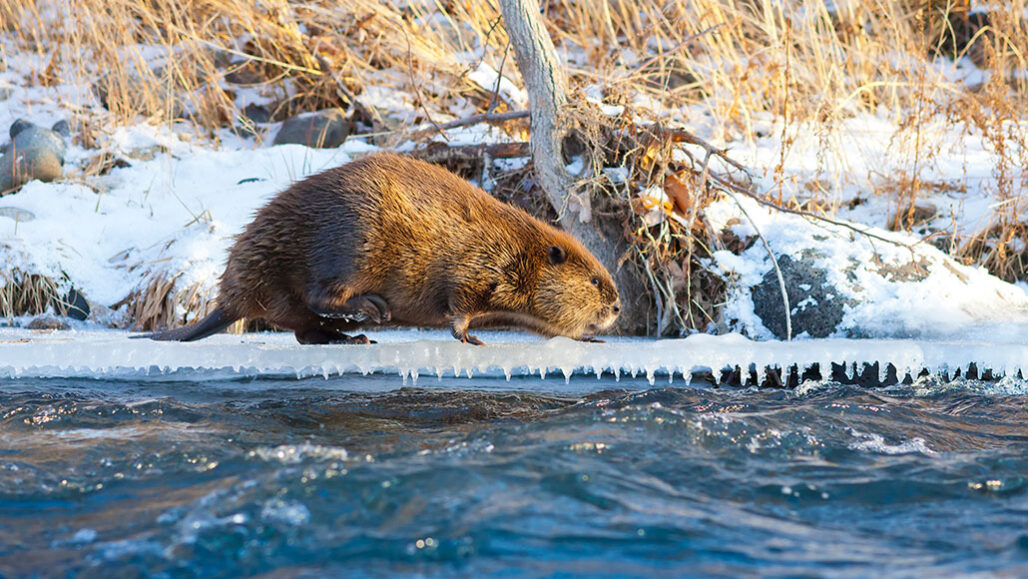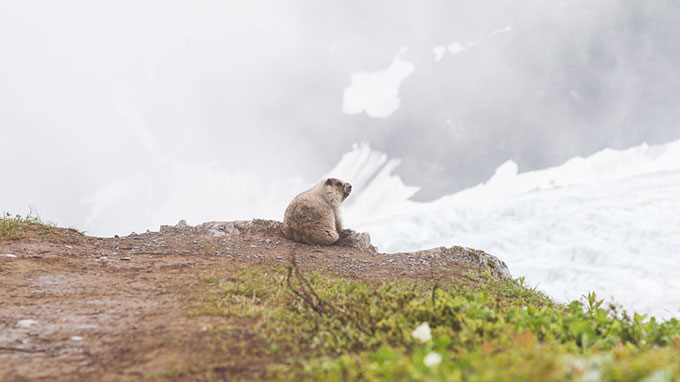Busy beavers may be speeding thaw of Arctic permafrost
Accelerating thaw threatens to boost climate change here, where it’s already warming quickly

A beaver sits on a snowy riverbank. Climate change and other factors have let the mammals expand their range in Alaska. Now they’re changing the landscape in ways that could release more greenhouse gases.
NeilLockhart/ iStock / Getty Images Plus
Beavers have been moving into more and more parts of Alaska’s Arctic wilderness. It now appears they’re changing the landscape in ways that could further fuel climate change. A new study shows how.
Permafrost is soil that has stayed frozen for more than two years. In some cases, it hasn’t thawed in thousands of years. In many places, this layer of permanently frozen soil can be more than 10 meters (33 feet) thick. But owing to climate change, many long-frozen parts of Earth’s surface have lately been warming. This causes uneven sinking of surface areas and makes some areas mushy.
This thaw also is releasing long-held stores of carbon dioxide. A potent greenhouse gas, it can warm Earth’s atmosphere. Earth’s climate had already warming. Indeed, the Arctic is warming faster than almost any place on Earth.
“Around the year 2000, beavers really started increasing their presence in northwest Arctic Alaska,” says Benjamin Jones at the University of Alaska Fairbanks. He studies how areas with permafrost underneath them have been changing. He was part of an international team that focused on the Baldwin Peninsula in the state’s far northwest. They chose this site because there are loads of high-resolution aerial and satellite photographs of the area. Some had been taken as far back as the 1950s. These would allow the team to see when and where any changes to the landscape might have occurred.
The detailed images can show features a few meters (yards) long, Jones notes. Among these: beaver dams. Master landscape architects, beavers build dams to back up water. They also build lodges in now-flooded areas. There, the swimming rodents store food and avoid predators.
Computer analyses helped Jones and his team track beaver dams over a 17-year period. Before 2000, photos showed evidence of few, if any, beavers. Two years later, there were two beaver dams in a 100-square kilometer (78.8-square mile) area. It was near the tip of the peninsula. By 2019, that area had 98 dams — nearly a 50-fold increase. For the whole northern part of peninsula, the number of dams went up more than fourfold from 2010 to 2019.
The amount of surface water also increased. In 2002, lakes and ponds near the peninsula’s tip covered 594 hectares (2.3 square miles). By 2019, there were 644 hectares (2.5 square miles). Beaver dams led to about two-thirds of the increase, Jones’ group found.
The team reported its findings in Environmental Research Letters on June 30.

Beaver-friendly sites
The beavers were damming low-lying regions — ones that had been rich with icy permafrost, Jones observes. These areas have a mix of mounds and low-lying areas. For beavers to build dams there “makes a lot of sense,” Jones says. The low areas let them back up water easily. The affected landscape is known as thermokarst (THUR-moh-karst). Its dirt and rock often settles unevenly as the permafrost there starts to m
The beavers’ landscape engineering may boost climate change. Warming here, in the Arctic, already had been increasing at a growing pace. As dams form ponds, more liquid water can come in contact with ice in the ground. That can more quickly thaw the permafrost below. The reason, Jones says, is that water conducts heat very well. That concept also explains why frozen meat defrosts faster in water than in air.
The team has several ideas about why more beavers moved in. Climate change is one likely factor. “The Arctic tundra is much shrubbier now than it was in the distant past,” notes Jones. Beavers can use shrubs for food and for dams. Also, warmer winters mean beavers can now stay year round in some places that were once too cold. Finally, he notes, beaver numbers have been rebounding from widespread hunting in the 1800s.
“We’ve always known that beavers are engineers,” says Audrey Sawyer. She’s a hydrogeologist at the Byrd Polar and Climate Research Center. It’s part of Ohio State University in Columbus. Sawyer studies how surface water interacts with groundwater. She finds especially interesting the study’s discovery of a so-called feedback cycle. As permafrost thaws, beavers move into thermokarst regions. The dams they build back up more surface water. And that “leads to more changes in permafrost.”

Dams make a difference
“When you start to get beavers in certain areas, it’s amazing how many dams they’ll build,” says Bethany Neilson. She’s an environmental engineer at the University of Utah in Logan. She didn’t take part in the new study. She has, however, worked at the Arctic Long Term Ecological Research site in Toolik, Alaska. She has also recently studied beaver impacts on surface and groundwater in parts of Utah.
In Utah, a warming climate is likely to lower how much water flows through streams and otherwise cut water supplies. The beavers’ actions could help hold water on the surface, Neilson’s team found. And those areas could provide places with cooler water for fish and other species. But that helpful effect might last only until the dams fail, she adds. Her team shared its findings last May 20 in Science of the Total Environment.
Indeed, the beavers’ activity in Alaska could cause lasting harm.
“Permafrost is a feature that has been part of the underground landscape in high latitudes for a long time,” says Sawyer at Ohio State. Frozen plants, animals and other life forms stored in permafrost will thaw. These all contain carbon.
“The amount of carbon that is stored in permafrost is immense,” Neilson notes. Thawing that permafrost will now release a large share of that carbon into the air, she adds, “which can create additional climate change.” Why? The thawed material will rot and break down. In the process, it will release carbon dioxide and other greenhouse gases.
The work by Jones’s group is “a great reminder of the importance of beavers as a keystone species,” Sawyer adds. That’s a species whose presence or absence can alter an ecosystem dramatically through its impacts on other living things. Now, she adds, science needs to consider their impacts on climate, too.







